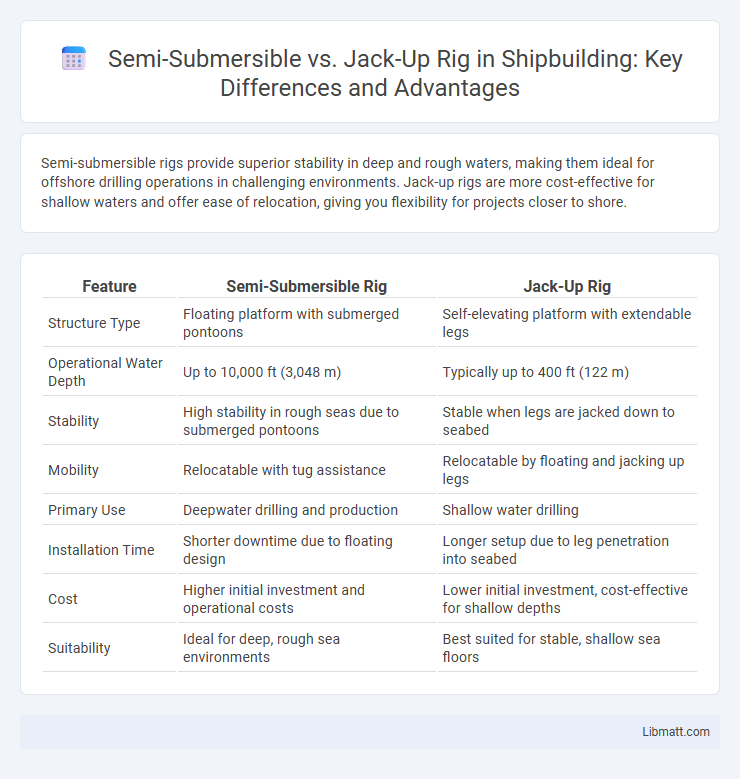Semi-submersible rigs provide superior stability in deep and rough waters, making them ideal for offshore drilling operations in challenging environments. Jack-up rigs are more cost-effective for shallow waters and offer ease of relocation, giving you flexibility for projects closer to shore.
Table of Comparison
| Feature | Semi-Submersible Rig | Jack-Up Rig |
|---|---|---|
| Structure Type | Floating platform with submerged pontoons | Self-elevating platform with extendable legs |
| Operational Water Depth | Up to 10,000 ft (3,048 m) | Typically up to 400 ft (122 m) |
| Stability | High stability in rough seas due to submerged pontoons | Stable when legs are jacked down to seabed |
| Mobility | Relocatable with tug assistance | Relocatable by floating and jacking up legs |
| Primary Use | Deepwater drilling and production | Shallow water drilling |
| Installation Time | Shorter downtime due to floating design | Longer setup due to leg penetration into seabed |
| Cost | Higher initial investment and operational costs | Lower initial investment, cost-effective for shallow depths |
| Suitability | Ideal for deep, rough sea environments | Best suited for stable, shallow sea floors |
Introduction to Offshore Drilling Rigs
Semi-submersible rigs float on water supported by pontoons and columns, ideal for deepwater drilling due to their stability in rough seas. Jack-up rigs rest on the seabed with extendable legs, providing a solid platform for shallow water drilling operations. Both rigs play crucial roles in offshore drilling, with choices depending on water depth and environmental conditions.
What is a Semi-submersible Rig?
A semi-submersible rig is a floating offshore drilling platform designed to operate in deep waters by partially submerging its hull below the sea surface, providing stability against waves and wind. It consists of pontoons and columns that support the drilling deck above water, allowing it to maintain position using dynamic positioning or anchors. Semi-submersible rigs are commonly used for oil and gas exploration in water depths ranging from 400 to over 10,000 feet, offering greater versatility compared to jack-up rigs, which are limited to shallower waters.
What is a Jack-up Rig?
A jack-up rig is a mobile offshore drilling unit typically used in shallow waters up to 150 meters deep, characterized by a buoyant hull and long legs that are lowered to the seabed for stability during drilling operations. It offers efficient drilling capabilities with rapid mobilization and demobilization, making it suitable for exploration and development in coastal and shelf areas. Compared to semi-submersible rigs, jack-up rigs have limited water depth range but provide cost-effective solutions in stable seabed conditions.
Key Design Differences
Semi-submersible rigs feature a buoyant hull structure that remains partially submerged, providing enhanced stability in deep waters and rough sea conditions. Jack-up rigs have extendable legs that rest on the seabed, making them ideal for shallow water operations with firm anchoring. Your choice between these rigs depends on water depth, environmental conditions, and project-specific requirements.
Operating Water Depths
Semi-submersible rigs operate efficiently in water depths ranging from 500 to over 10,000 feet, making them ideal for deepwater and ultra-deepwater drilling. Jack-up rigs, however, are best suited for shallow waters, typically up to 400 feet, due to their extendable legs that rest on the seabed. Your choice between these rigs depends significantly on the depth of the water at your drilling site.
Mobility and Deployment
Semi-submersible rigs offer superior mobility and can be quickly relocated across deepwater sites, making them ideal for offshore drilling in diverse and remote locations. Jack-up rigs are limited to shallower waters and rely on extending legs to the seabed for stability, which requires more time to deploy and move between sites. Your choice depends on the water depth and the need for rapid redeployment during exploration and production phases.
Stability in Harsh Environments
Semi-submersible rigs offer superior stability in harsh environments due to their submerged pontoons, which minimize wave impact and provide excellent resistance to rough seas and strong winds. Jack-up rigs rely on extendable legs that anchor to the seabed, offering firm stability in shallow waters but limited performance in deep water or severe weather conditions. Your choice depends on the water depth and environmental challenges, with semi-submersibles preferred for deep, turbulent waters and jack-ups suited for shallower, more stable areas.
Safety Features and Concerns
Semi-submersible rigs offer enhanced stability in deep waters due to their submerged pontoons, significantly reducing the risk of capsizing during storms. Jack-up rigs provide a solid foundation by extending legs to the seabed, minimizing wave-induced movements but face concerns related to leg structural integrity under severe seabed conditions. Safety features on semi-submersibles include dynamic positioning systems and ballast control to maintain stability, whereas jack-ups focus on leg jacking systems and load monitoring to prevent structural failures.
Cost Comparison and Economics
Semi-submersible rigs generally have higher upfront costs and operational expenses due to their complex design and deeper water capabilities, making them more suitable for deepwater drilling projects. Jack-up rigs offer a more cost-effective solution for shallow water operations, with lower mobilization and maintenance costs, optimizing economic efficiency in less challenging environments. The choice between the two rigs heavily depends on water depth and project scale, directly impacting the overall drilling budget and return on investment.
Choosing the Right Rig for Offshore Projects
Selecting the right rig for offshore projects hinges on water depth and environmental conditions; semi-submersible rigs offer excellent stability in deep waters and rough seas, while jack-up rigs are ideal for shallow waters and more stable environments. Your project's operational demands, such as drilling depth and mobility, determine which rig maximizes safety and efficiency. Prioritizing rig type based on these factors ensures optimal performance and cost-effectiveness in offshore drilling operations.
Semi-submersible vs jack-up rig Infographic

 libmatt.com
libmatt.com